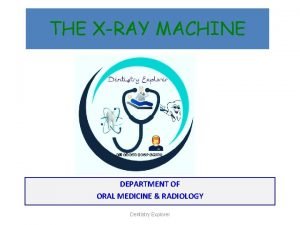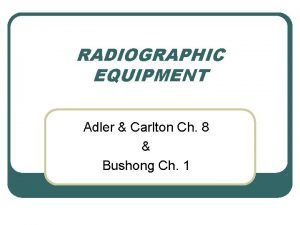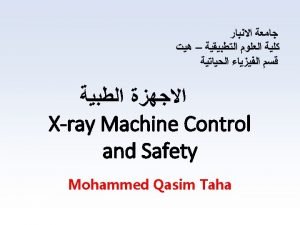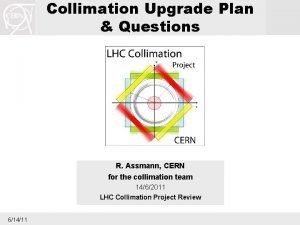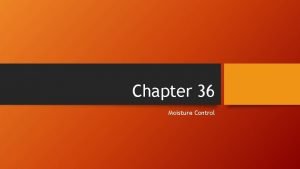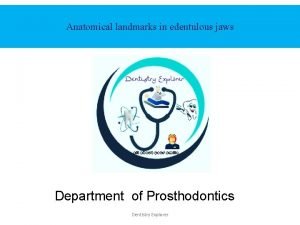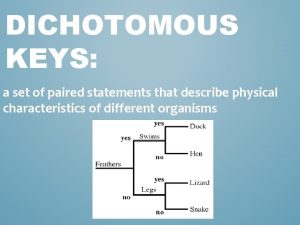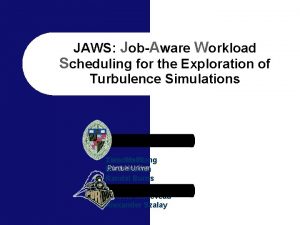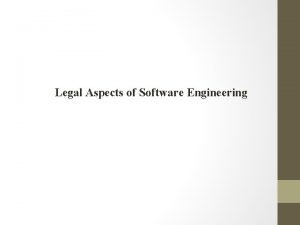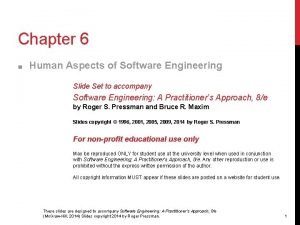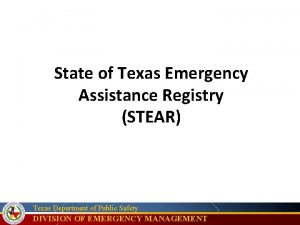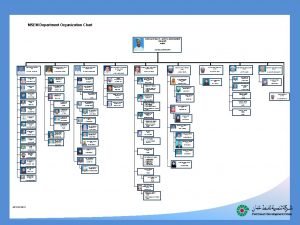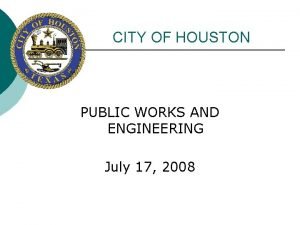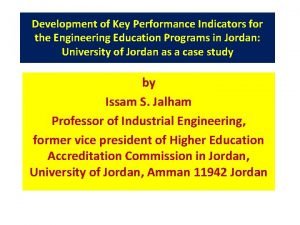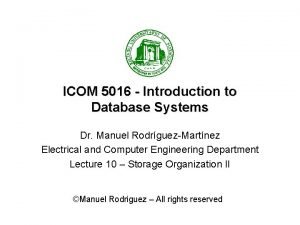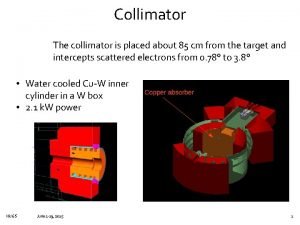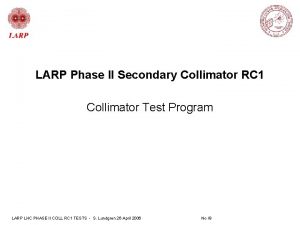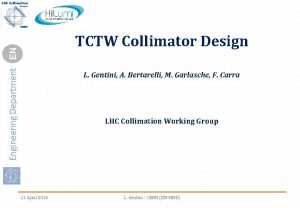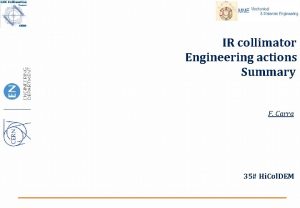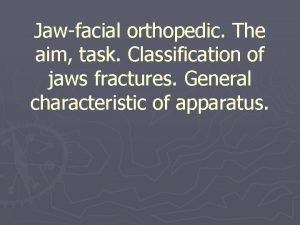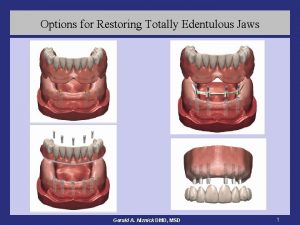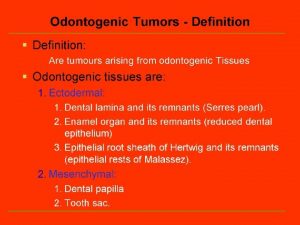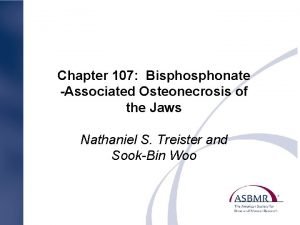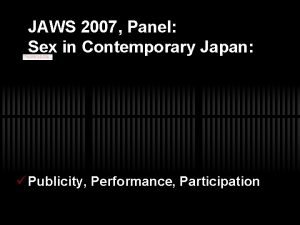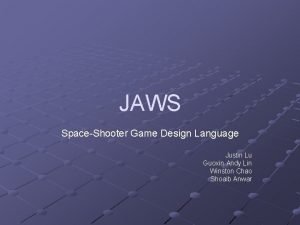Engineering Department EN HRMT23 Collimator Jaws Safety Aspects




















![Safety Aspects Engineering Department EN Material Estimated Mass [kg] Components Aluminium AW-6082 Actuation 800 Safety Aspects Engineering Department EN Material Estimated Mass [kg] Components Aluminium AW-6082 Actuation 800](https://slidetodoc.com/presentation_image_h/3301c8e5ac6da43042c286e3cc354601/image-21.jpg)













- Slides: 34

Engineering Department EN HRMT-23 – Collimator Jaws: Safety Aspects Hi. Rad. Mat Technical Board Meeting 15. 10. 2014 A. Bertarelli – CERN EN/MME on behalf of E. Berthomé, F. Carra, A. Dallocchio, M. Garlaschè, L. Gentini, P. Gradassi, M. Guinchard, E. Quaranta, S. Redaelli, A. Rossi, O. Sacristan, G. Valentino 15. 10. 2014 Alessandro Bertarelli – EN-MME 1

Engineering Department EN Outline § HRMT 23 experiment overview § Operation phases & pulse list proposal § Safety aspects § Radiation protection measures § Summary 15. 10. 2014 Alessandro Bertarelli – EN-MME 2

Engineering Department EN Outline § HRMT 23 experiment overview § Operation phases & pulse list proposal § Safety aspects § Radiation protection measures § Summary 15. 10. 2014 Alessandro Bertarelli – EN-MME 3

Engineering Department EN HRMT-23 Experiment Goals § Integrally test under LIU-SPS beam (up to 288 b, ideally 2. 3 e 11 p/b) jaws for HL -LHC collimators (simulation of ultimate HL-LHC Injection Error) § Determine damage thresholds for HL-LHC Jaws (if lower than ultimate HL-LHC Injection Error) § Acquire online data about response of complete jaws to beam impact § Assess impact consequences on jaws components after irradiation HRMT-23: Test of Fully Assembled Jaws § 15. 10. 2014 Main Features: § Three superposed jaws in one tank. § Jaws equipped with set of strain gauges, sensors, … for online acquisition. § Special tank equipped with viewports for optical acquisition, LDV, electric connections etc. and fast dismounting system for glove box post-irradiation observations. Alessandro Bertarelli – EN-MME 4

Engineering Department EN Preliminary Beam Specification Beam parameters shall be consistent with LIU/HL-LHC injection scheme (ideally reaching up to expected HL-LHC intensity and emittance). Preliminary beam parameters: § Beam energy: 440 Ge. V § Bunch spacing: 25 ns § Bunches per pulse: 1 to 288 § Protons/bunch: (desirably) up to 2. 3 e 11 p/b § Beam size: 1 x 1 mm 2 down to ~0. 5 x 0. 5 mm 2 at maximum intensity (beam size should match expected HL-LHC emittance, however it may be reduced to 0. 3 x 0. 3 mm 2 to compensate for possible lack of beam intensity…) § Impact parameter: 1 to 5 mm § Total expected number or protons ~ 3 e 14 p 15. 10. 2014 Alessandro Bertarelli – EN-MME 5

Engineering Department EN HRMT-23 Overall Design § 3 separate complete jaws extensively instrumented. § Stainless steel vacuum vessel (p > 10 -3 mbar). Quick dismounting system to access and manipulate jaws in a glove box. § Be/CFC vacuum windows: design to withstand higher energy density and intensity § Horizontal actuation inspired by collimator movable tables; Stroke (H): 28 mm § Vertical movement of the whole tank; stroke (V) +/ -142 mm. 3 separate beam windows sets for each jaw § Control system derived from HRMT-14 § Standard Hi. Rad. Mat support table: § Total envelope: 1. 2(H) x 0. 4(W)x 2. 1(L) m 3 § Total mass ~ 1600 kg 15. 10. 2014 Alessandro Bertarelli – EN-MME 6

Engineering Department EN HRMT-23 Containment § Vacuum environment: no risk of external contamination § 304 L vacuum tank verified against static and buckling failure scenarios (G. Maitrejean, EDMS 1402980) § Be/CFC vacuum windows: designed to withstand higher energy density and intensity (G. Maitrejean, EDMS 1402982) § View ports equipped with special radiation-hard glasses (RS 323 G 19 grade from Schott): robustness and good transparency also in case of high doses § Vacuum seals: same concept and materials (EPDM/viton) successfully adopted for HRMT 14 § Special movable system with protection glasses to stop ejecta possibly produced at high intensity impacts, protectthe container and allow external observations 15. 10. 2014 Alessandro Bertarelli – EN-MME 7

HRMT-23 Jaws To Be Tested Currently envisaged proposal for Jaws: Engineering Department EN 1. HL-LHC Secondary Collimator Jaw (TCSPM) with 10 Molybdenum Carbide – Graphite inserts (some inserts possibly coated). 2. HL-LHC Secondary Collimator Jaw (TCSPM) with 10 Copper – Diamond inserts. 3. TCSP jaw: to verify the resistance of Phase I C/C jaw to beam injection accident with HL-LHC parameters (double intensity, smaller emittance w. r. t Phase I) … 15. 10. 2014 Alessandro Bertarelli – EN-MME 8

Engineering Department EN HRMT-23 Jaws Assembly § Each jaw can be (mounted and) dismounted independently to ease post-irradiation manipulation § A small independent water expansion tank will be installed on 2 TCSPM jaws to allow measuring pressure burst in cooling circuits Simulations to be performed to assess energy deposition and pressure burst in water! § TCSP jaw recovered from spare (outgassing) TCSP collimator 15. 10. 2014 Alessandro Bertarelli – EN-MME 9

Engineering Department EN HRMT-23 Thermal Simulations TCSx with Mo. GR Tmax<Tmelt, Mo. GR > 2000° Temp (C) TCSx with Cu. CD Molten region! Tmax>>Tmelt, Cu. CD 15. 10. 2014 Alessandro Bertarelli – EN-MME FLUKA energy deposition maps courtesy of S. Lefteris 10

HRMT-23 DAQ and Electronics Engineering Department EN § Instrumentation (MME Mechanical Lab). Main objectives: § Acquire online pressure waves on most relevant components (mostly jaw inserts). § Acquire online temperatures on relevant locations. § Detect online high speed vibrations (pressure wave – induced ) § Detect online low speed oscillations (full jaw flexural modes) § Detect offline (possible) permanent jaw deformation § Visually Record (possible) jaw explosion / fragmentation § Detect offline (possible) internal material damage (e. g. delamination, cracks, tunneling …) § Record online pressure burst in water cooling pipes § Motorization: controls and hardware compatible with HRMT-14. Updated software interface required. Help by EN/STI/ECE … § Acquisition System: the DAQ hardware and infrastructure should be designed and implemented with a comprehensive view on a larger spectrum of Hi. Rad. Mat Experiments Synergy with and contribution from other experiments and projects. 15. 10. 2014 Alessandro Bertarelli – EN-MME 11

HRMT-23 Instrumentation Engineering Department EN § Sensor positioning (adjustable) Strain gauge Temperature probe Laser Doppler Displacement Sensor 15. 10. 2014 Alessandro Bertarelli – EN-MME 12

HRMT-23 Advanced Instrumentation Engineering Department EN § Ultrasonic non destructive tests. Under study, not yet confirmed. Ø Ultrasonic mapping along Z axis Ø Cracks and phase changes in the jaws Ø Not online… checking between impacts Ø Probe compatible with 1000 k. Gy and 350°C 15. 10. 2014 Alessandro Bertarelli – EN-MME 13

HRMT-23 Advanced instrumentation Engineering Department EN § Distributed strain measurements by FOS. To be studied. Ø Beam perturbation should be limited Ø No impact on the channel numbers for the DAQ Ø Fast DAQ (2 MHz) 14 15. 10. 2014 Alessandro Bertarelli – EN-MME

Engineering Department EN Outline § HRMT 23 experiment overview § Operation phases & pulse list proposal § Safety aspects § Radiation protection measures § Summary 15. 10. 2014 Alessandro Bertarelli – EN-MME 15

Engineering Department EN Operation Phases § Test runs: Late Spring 2015 § Expected experiment duration: 1 full week § At least two persons from the experiment team to stay in the CR during all phases of the experiment set-up and test runs § HRMT 23 team can access DAQ control system from any CERN standard computer via LAN connection (Virtual Machine). § No access request is expected during tests, except in case of issues and in any case in line with safety rules. § Webcams will be placed underground to identify possible issues and evaluate solutions before requesting a direct access. § After the experiment: equipment to be placed in the facility storage area for the time required to decrease to an acceptable activation level. § Attention to be paid in not damaging vacuum bellows during handling! 15. 10. 2014 Alessandro Bertarelli – EN-MME 16

Pulse List (Tentative) Engineering Department EN No 1 -50 51 52 53 54 55 56 57 58 59 60 61 62 63 64 65 66 67 68 -117 118 119 120 121 Intensity Beam spot [mm] Bunch Pulse length [us] # bunches p/bunch Total Sigma_x Sigma_y spacing [ns] 1 1 2 4 8 12 24 1 8 16 32 72 144 1 4 8 16 36 1 288 144 288 5. 00 E+10 1. 50 E+11 1. 50 E+11 5. 00 E+10 2. 20 E+11 5. 00 E+10 1. 50 E+11 3. 00 E+11 6. 00 E+11 1. 20 E+12 1. 80 E+12 3. 60 E+12 1. 50 E+11 1. 20 E+12 2. 40 E+12 4. 80 E+12 1. 08 E+13 2. 16 E+13 1. 50 E+11 6. 00 E+11 1. 20 E+12 2. 40 E+12 5. 00 E+10 6. 34 E+13 3. 17 E+13 6. 34 E+13 0. 61 1 1 1 0. 61 0. 61 0. 61 25 25 25 25 25 25 0. 025 0. 05 0. 1 0. 2 0. 3 0. 6 0. 025 0. 2 0. 4 0. 8 1. 8 3. 6 0. 025 0. 1 0. 2 0. 4 0. 9 0. 025 7. 2 3. 6 7. 2 Alignment, pilot bunches Damage threshold for TCSP buttons/taperings Safe (? ) Limit for TCSPM Mo. Gr jaw Damage threshold for TCSPM Cu. CD jaw Alignment, pilot bunches HL-LHC beam injection error “wish” case Total intensity ~ 3 E 14 protons 15. 10. 2014 Alessandro Bertarelli – EN-MME 17

Engineering Department EN Pulse List: Remarks § Bunch number and bunch intensity are indicative and may be adjusted as a function of the operation needs: what matters is the pulse intensity § HL-LHC injection error scenario can be highly destructive for Cu. CD: this is why an intermediate impact with half of the intensity has been added to the table § In case 6. 4 E 13 intensity is not achievable, the maximum intensity available will be requested, decreasing the beam size down to a value acceptable for the Be window § Possible alternative option discussed at Joint HL-LHC WP 2 -WP 5 and Col. USM#46 meeting: 288 b, 1. 6/1. 7 E 11 p/b if scrubbing is successful; also small emittance could be obtained with BCMS beams 15. 10. 2014 Alessandro Bertarelli – EN-MME 18

Engineering Department EN Outline § HRMT 23 experiment overview § Operation phases & pulse list proposal § Safety aspects § Radiation protection measures § Summary 15. 10. 2014 Alessandro Bertarelli – EN-MME 19

Engineering Department EN Safety Aspects § No particular issues for safety are expected § No toxic, no flammable materials § Summary of materials, hazard inventory and risk analysis tables prepared Material Density (g/cm 3) N. of Blocs Bloc Size (mm 3) Total Weight (g) Mo. Gr 2. 48 10 100 x 45 x 25 2810 Cu. CD 5. 4 10 100 x 45 x 25 6080 AC 150 -K 1. 67 1 1054 x 80 x 25 3520 Material Name Mo. Gr Cu. CD AC 150 -K 15. 10. 2014 Element Density (g/cm 3) Weight Fraction (%) C Mo Cu B CD C 2. 27 10. 28 8. 93 2. 34 3. 51 2. 27 88. 79 11. 21 62. 06 0. 41 37. 53 73. 6 Alessandro Bertarelli – EN-MME Active jaw materials: size, weight, chemical composition 20
![Safety Aspects Engineering Department EN Material Estimated Mass kg Components Aluminium AW6082 Actuation 800 Safety Aspects Engineering Department EN Material Estimated Mass [kg] Components Aluminium AW-6082 Actuation 800](https://slidetodoc.com/presentation_image_h/3301c8e5ac6da43042c286e3cc354601/image-21.jpg)
Safety Aspects Engineering Department EN Material Estimated Mass [kg] Components Aluminium AW-6082 Actuation 800 Kg Stainless steel Vacuum tank, beam line flanges and bellows 600 Kg Copper-Beryllium RF contacts, mirror clamps 2 Kg Brass LVDT axis 0. 3 Kg Glidcop Al-15 Collimator jaw housing and stiffener 100 Kg Rad-hard glass Optical windows 10 Kg Beryllium Vacuum windows 0. 05 Kg Copper-Nickel Cu. Ni 90 Collimator cooling pipes -10 Zerodur® glass. Mirrors ceramic Conductor : Bare copper Insulation : PE Pair screening: Al/ PETP/Al Cables foil Overall screening : 0, 15 mm tinned copper braid, Polyimide support Strain gauges Constantan foil Glue PCB Cards for the switch 15. 10. 2014 Epoxy resin Other materials adopted for the experimental apparatus 10 kg 2 Kg 12 negligible Fiberglass, copper, and resin 2 Alessandro Bertarelli – EN-MME 21

Hazard Inventory Engineering Department EN § § § Pressure: § Shockwave max. pressure ~ 10 GPa § Vacuum: 10 -3 mbar Thermal properties of materials to be tested Specific Heat [J/kg/K] Thermal Conductivity [W/m/K] Mo. Gr ~700 770* Cu. CD 420 490 AC 150 -K 710 200* 304 L 500 16 Aluminium 900 170 Ionizing radiations: § Particle type: protons § Pulse intensity: up to 288 bunches, 2. 5 E 11 p/b § Beam energy: 440 Ge. V Rad-hard glass 580 0. 75 Zerodur® ~800 ~1 Beryllium 1825 200 Copper 385 390 Copper-Beryllium 420 115 Motor: § Lateral speed: 240 mm/min § Vertical speed: 120 mm/min Copper-Nickel 380 40 Temperature: § ΔT on the most loaded jaw~ 7000 K Electricity (to be confirmed): § 24 V § 4 Capacitors: 400 V; 3300 μF 15. 10. 2014 Material Alessandro Bertarelli – EN-MME 22

Engineering Department EN Risk Analysis Everyone involved in setting up the experiment will complete the required CERN safety courses (EDMS n. 1154948) 15. 10. 2014 Alessandro Bertarelli – EN-MME 23

Engineering Department EN Outline § HRMT 23 experiment overview § Operation phases & pulse list proposal § Safety aspects § Radiation protection measures § Summary 15. 10. 2014 Alessandro Bertarelli – EN-MME 24

Engineering Department EN HRTM-23 RP measures § All experiment phases are controlled remotely, no access request is expected during tests § Some of the materials to be irradiated have already been tested in Hi. Rad. Mat during HRMT 09 and HRMT 14 experiments § A radiological assessment document for HRMT 14 has been prepared (https: //edms. cern. ch/document/1224692/1). § After irradiation, the time taken by the dismounting operations will be minimized, thanks to the special rapid dismounting system designed 15. 10. 2014 Alessandro Bertarelli – EN-MME 25

HRMT-23 Post Irradiation Plan Engineering Department EN Two possible options currently being investigated: § Acquisition (jointly with other partners, e. g. ISOLDE? ), of a Glove Box allowing post irradiation analyses of several experiments (HRMT 9, HRMT 14, HRMT 23 and Multi. Mat) § Exploiting existing facilities in building 109 equipped to work on contaminated materials (currently checking with RP if possible). 14. 10. 2014 A. Bertarelli – EN-MME 26

HRTM-23 Post-irradiation Plan Engineering Department EN § § After irradiation, additional analyses are foreseen. These include: § Remote observation of impacted jaws through cameras, LDV and ad-hoc viewports (on upstream and downstream sides of vacuum vessel) § Direct observation and in-situ measurements of impacted jaws after dismounting of the tank § After appropriate cool-down time, dismounting of collimator components (jaws and jaw part) in a convenient Glove Box. § Cutting of material specimens in a Glove Box § Metrology, NDT and analysis of cut samples Waiting for feedbacks from German supplier 15. 10. 2014 Alessandro Bertarelli – EN-MME 27

Engineering Department EN Post-irradiation Manipulation § Three collimator jaws in a vacuum tank § Each jaw to be tested under intense proton beam as of Spring 2015. Vacuum tank Collimator Jaws Beam 15. 10. 2014 Alessandro Bertarelli – EN-MME 28

Post-irradiation Manipulation § All manipulations to be performed in the Glove Box. ~2100 Whole Mass: ~1400 kg ~1800 Engineering Department EN § Phase 1: Remove vacuum vessel cover (Glove Box Station 1). 1 Remove 22 clamps and lift cover of the vacuum tank. 29

Post-irradiation Manipulation Engineering Department EN § Phase 2: Remove jaw assembly (Glove Box Station 1). ~2100 Jaw Assembly Mass: ~ 140 kg ~1900 Jaw bolts ~1 20 0 15. 10. 2014 2 3 Unscrew the jaw bolts Remove the jaw assembly Alessandro Bertarelli – EN-MME 30

Post-irradiation Manipulation Engineering Department EN § Phase 3: Remove each independent jaw (Glove Box Station 2). ~1300 Jaw Mass: ~ 40 kg ~500 Jaw bolts 15. 10. 2014 2 3 Position jaw assembly in Station 2 Unscrew jaw bolts and dismount the tree jaws Alessandro Bertarelli – EN-MME 31

Post-irradiation Manipulation Engineering Department EN § Phase 4: Remove jaw components as required (Glove Box Station 2). § Phase 5 (and following): Cut, clean, condition, extract samples as required (Glove Box Station 3) 15. 10. 2014 Alessandro Bertarelli – EN-MME 32

Glove Box Estimated Dimensions Engineering Department EN § Overall maximum dimensions of components to be disassembled in Station 1 are 2200 x 1900 x 1200 mm. § Overall maximum dimensions of components to be disassembled in Station 2 are 1300 x 500 mm. § Typical dimensions of components to be manipulated in Station 3 are 200 x 100 mm. § External dimensions of experiments not presented here are expected to fall within given envelopes. 15. 10. 2014 Alessandro Bertarelli – EN-MME 33

Engineering Department EN Thank you for your attention! Questions? 15. 10. 2014 Alessandro Bertarelli – EN-MME 34
 Collimator types
Collimator types Collimator of x ray tube
Collimator of x ray tube Collimator types
Collimator types Collimator
Collimator Collimator
Collimator Jaws protagonist
Jaws protagonist Dental dam forceps are positioned with the beaks facing
Dental dam forceps are positioned with the beaks facing Anatomical landmarks of edentulous mandible
Anatomical landmarks of edentulous mandible Penguin dichotomous key
Penguin dichotomous key Jaws inspiration
Jaws inspiration Jobaware
Jobaware Physiological rest position
Physiological rest position Legal aspects of software engineering
Legal aspects of software engineering Human aspects of software engineering
Human aspects of software engineering Undss logo
Undss logo State of texas emergency assistance registry
State of texas emergency assistance registry Virginia department of agriculture and consumer services
Virginia department of agriculture and consumer services Ohio department of agriculture food safety
Ohio department of agriculture food safety Safety department organization chart
Safety department organization chart Georgia motor carrier compliance division
Georgia motor carrier compliance division Electrical engineering department
Electrical engineering department Hotel engineering department
Hotel engineering department City of houston department of public works and engineering
City of houston department of public works and engineering What is kpi in engineering
What is kpi in engineering Department of information engineering university of padova
Department of information engineering university of padova Department of information engineering university of padova
Department of information engineering university of padova Tum department of electrical and computer engineering
Tum department of electrical and computer engineering Iit delhi material science
Iit delhi material science Bridgeport engineering department
Bridgeport engineering department Bridgeport engineering department
Bridgeport engineering department Computer engineering department
Computer engineering department Ucla systems engineering
Ucla systems engineering University of sargodha engineering department
University of sargodha engineering department Ecdis safety settings
Ecdis safety settings Safety care certification
Safety care certification
